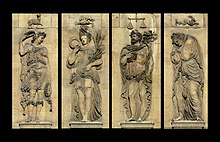
KNOWPIA
WELCOME TO KNOWPIA
Summary
There are a number of deities and personifications associated with seasons in various mythologies, traditions, and fiction.

Winter edit
- Kheimon, from Greek kheima, a hora of winter, early ancient Greece[1]
- Beira, Queen of Winter, also Cailleach Bheur, a personification or deity of winter in Gaelic mythology
- Boreas (Βορέας, Boréas; also Βορρᾶς, Borrhás) was the Greek god of the cold north wind and the bringer of winter. His name meant "North Wind" or "Devouring One". His name gives rise to the adjective "boreal".
- Despoina (Δέσποινα) is the daughter of Poseidon and Demeter, greek goddess of winter and frost
- Khione (from χιών – chiōn, "snow") is the daughter of Boreas and Greek goddess of snow
- Ded Moroz (literally "Grandfather Frost"), a Russian substitute of Santa Claus
- Father Winter – Albanian mythology [citation needed]
- Itztlacoliuhqui, deified personification of winter-as-death in Aztecan mythology
- Jack Frost
- Tengliu, Snow goddess from Chinese mythology.
- the Great Winter God (冬大神), of Ba Jia Jiang (The Eight Generals), originated from the Chinese folk beliefs and myths
- Marzanna, slavic Goddess of Winter, Death, and Rebirth (also Marena, Morena, Morana, Mara, Maslenitsa).
- Morozko, from a Russian fairy tale, translated as Father Frost
- Old Man Winter, personification of winter.
- Skaði (sometimes anglicized as Skadi, Skade, or Skathi) is a jötunn and goddess associated with bowhunting, skiing, winter, and mountains in Norse mythology
- Hine-Takurua Personification of the winter in Māori mythology and one Tamanuiterā, the sun god's two wives[citation needed]
- Three Friends of Winter in Chinese art, the plum, bamboo and pine.
- Shakok the god of winter the North Mountain in Native American mythology
- Nane Sarma, Granma Frost, Iranian folklore.
Spring edit
- Ēostre, West Germanic spring goddess; she is the namesake of the festival of Easter in some languages.
- Brigid, celtic Goddess of Fire, the Home, poetry and the end of winter. Her festival, Imbolc, is on 1st or 2nd of February which marks "the return of the light".
- Persephone, greek Goddess of Spring. Her festival or the day she returns to her mother Demeter from the Underworld is on 3rd of April.
- Many fertility deities are also associated with spring
- In Roman mythology, Flora was a Sabine-derived goddess of flowers[2] and of the season of spring[3]
- Jarylo (Cyrillic: Ярило or Ярила; Polish: Jaryło; Croatian: Jura or Juraj; Serbian: Jarilo; Slavic: Jarovit), alternatively Yarylo, Iarilo, or Gerovit, is a Slavic god of vegetation, fertility and springtime.[4]
- Eiar, a hora of spring, classic ancient Greece.
- the great Spring God (春大神), of Ba Jia Jiang (The Eight Generals), originated from the Chinese folk beliefs and myths
- Morityema the god of spring & the West Mountain in Native American mythology.
Summer edit
- Áine, Irish goddess of love, summer, wealth and sovereignty, associated with the sun and midsummer
- Theros, a hora of summer, classic ancient Greece
- Damia, a hora of summer, early ancient Greece
- the Great Summer God (夏大神), of Ba Jia Jiang (The Eight Generals), originated from the Chinese folk beliefs and myths
- Freyr, Norse god of summer, sunlight, life and rain
- Hine-Raumati, Personification of the summer from Māori mythology
- Miochin the god of summer & the South Mountain in Native American Mythology
Autumn edit
- Pthinoporon, from Greek phthinophôron, a hora of autumn, classic ancient Greece
- the Great Autumn God (秋大神), of Ba Jia Jiang (The Eight Generals), originated from the Chinese folk beliefs and myths
- Shruisthia the god of autumn & the East Mountain in Native American Mythology
Anemoi edit
In ancient Greek mythology Anemoi were the gods of wind, three of which were associated with seasons:
- Boreas (Septentrio in Latin) was the north wind and bringer of cold winter air
- Zephyrus or Zephyr (Favonius in Latin) was the west wind and bringer of light spring and early summer breezes
- Notus or Notos (Auster in Latin) was the south wind and bringer of the storms of late summer and autumn. Notos not only brings rain and heavy downpour, but he can also bring extremely hot air (avg. 45°C) especially in the southern parts of Greece.
- Eurus (Eurus in Latin) was the East Wind & bringer of warmth & rain


